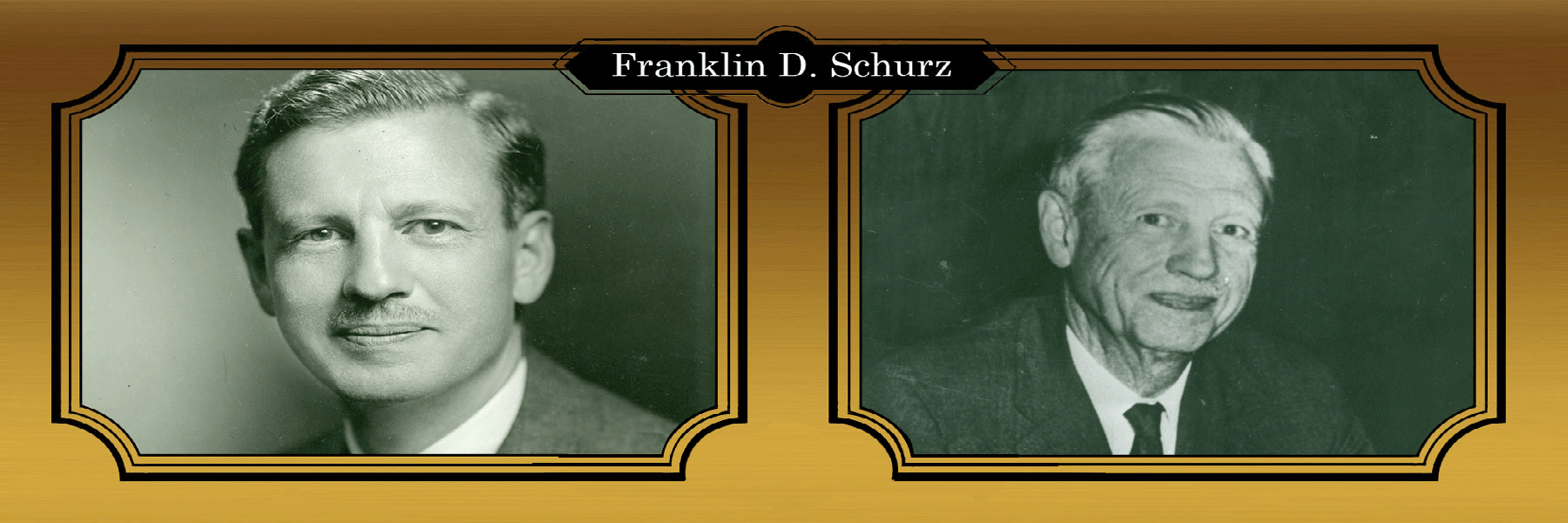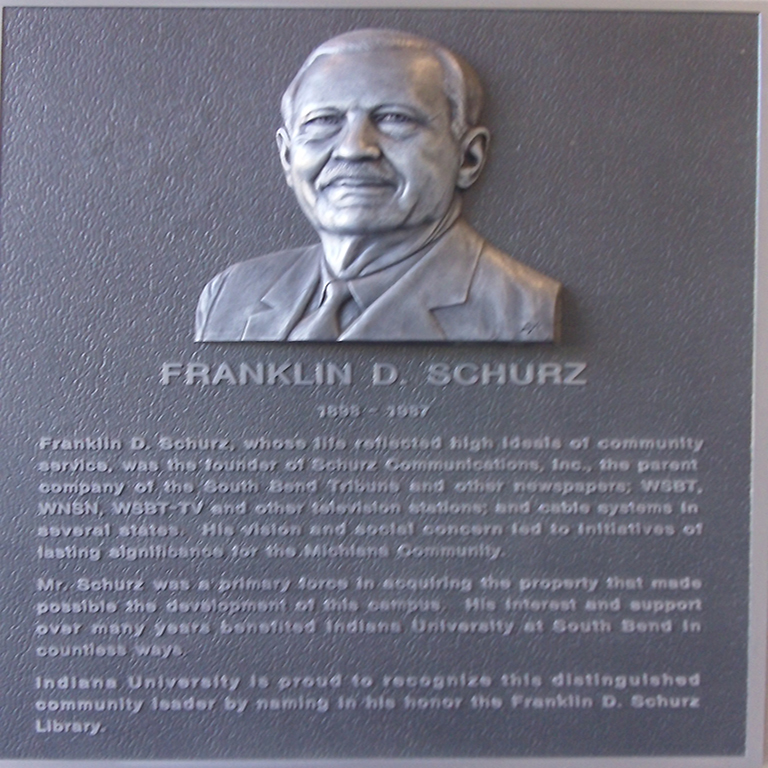Franklin Dunn Schurz (1898-1987) was owner and publisher of the South Bend Tribune, and Chairman of Schurz Communications, a media group that included the Tribune, seven other newspapers in Indiana, Maryland, Kentucky and California, and four television stations.
Archives and Special Collections has a selected collection of documents, photos, awards and memorabilia that document Schurz's life, with emphasis on the period between 1950 and 1970. Contact Scott Shoger, IU South Bend Archivist, sshoger@iusb.edu or 574-520-4392.
View Schurz's work in business community and public affairs
Born in South Bend on March 8, 1898, Franklin D. Schurz was the only son of John Giles Schurz who worked as an accountant, and Grace Dunn Schurz, a descendant of a local pioneer family. After graduating from South Bend High School, Harvard University and the Harvard Business School in 1921, he worked briefly for the Food Research Institute at Stanford University. He earned his CPA in California before returning to South Bend in 1924 to work with his father in an accounting firm. It was his uncle, F. A. Miller, the newspaper’s owner and publisher who coaxed his 27-year-old nephew into joining the Tribune in 1925.
Over the course of the next 30 years, his uncle trained Mr. Schurz in virtually every aspect of its operations. Despite working in the shadow of his uncle, Mr. Schurz demonstrated early on that he was a progressive and innovative leader. In the late 1920s, it was Mr. Schurz’s idea to focus on the area’s west side to boost readership. In a deadly circulation battle with the News-Times, Mr. Schurz’s community efforts were so successful that the Tribune surpassed the News-Times in circulation. After four years at the Tribune, Mr. Schurz was made vice president. In 1929 he also married Martha Montgomery, whom he had met at Stanford earlier. They had three sons – Franklin Jr., James, Scott and a daughter, Mary.
Among his responsibilities at the Tribune were serving as station manager for the Tribune's radio station WSBT, as business manager of the Tribune, and finally, on the death of Miller, as editor/publisher (1954-72). Mr. Schurz was instrumental in moving the company into television with WSBT, the nation’s oldest UHF, which went on the air in 1952. During the 1960s and 1970s, he began to acquire additional newspapers and television stations, extending the Tribune properties coast to coast. In the Tribune organization he held the offices of vice president (1929-46), secretary and treasurer (1946-57), president (1957-75), and chairman of the board (1975-76). In 1976, he became chairman of the board of the newly constructed organization, Schurz Communications Incorporated.
In the newspaper industry his influence extended beyond South Bend. He helped lead the way for the adoption of various automated printing processes, offering the Tribune as a pilot plant for the development of letterpress and other innovations. The American Newspaper Publishers Association (ANPA) hailed Mr. Schurz as “one of the world’s leading pioneers in newspaper technology.”
Among his many honors, Mr. Schurz was the first editor or publisher from Indiana to be elected to the Associated Press board of directors and served as its first vice president. He was the first director of the American Newspaper Publishers Association’s Research Institute, president of the Inland Daily Press Association, and the director of the Hoosier State Press Association.
Beyond his family and business activities, Mr. Schurz’s primary interest was in the greater South Bend community. He chaired the War Finance Committee in St. Joseph County during World War II, served as president of the YWCA’s board of trustees for 24 years, and co-chaired the United Fund of St. Joseph County when it was first organized. Despite his influence, Mr. Schurz remained a quiet man, preferring to work behind the scenes in civic matters. University of Notre Dame President Hesburgh noted that Mr. Schurz “gracefully let others take the credit.”
Mr. Schurz became quite visible as co-chair, along with Paul D. Gilbert, of the Committee of 100, an emergency civic committee formed in 1954 to bring new business to South Bend. After the shutdown of the Studebaker automobile manufacturing plant late in 1963, Mr. Schurz committed hundreds of hours, many in Washington D.C., to improving the lives of the thousands of suddenly unemployed auto workers. He succeeded in forcing the federal government into action. Approximately 2,500 former Studebaker employees were retrained under the program that he headed and found new jobs. Additionally, Mr. Schurz chaired the St. Joseph County Manpower Development and Training Advisory Committee and the Indiana State Governor’s Manpower Advisory Committee. Mishawaka Mayor Robert C. Beutter said “whenever the community had problems, he was in the forefront. His quiet but effective leadership was always present to put out brush fires and to keep the community moving in the right direction.”
Along with fostering economic development, Mr. Schurz was a dedicated advocate of higher education. He served on the board of trustees for the University of Notre Dame and St. Mary's College, receiving honorary degrees from both institutions. His connection with Indiana University South Bend began early in his career. When Mr. Schurz came to work in the evenings, he noticed that the lights were on in the high school’s basement located across the street from the Tribune building. Upon discovering that Indiana University extension courses were being held there, he felt strongly that students wanting to better themselves deserved a better place to work. Many years later Mr. Schurz learned of IU President Herman Wells’ potential interest in putting up a building in South Bend if land was given to Indiana University. Working through the Committee of 100, Mr. Schurz was pivotal in purchasing and securing land in the late 1950s for a new IU South Bend campus on the banks of the St. Joseph River.



